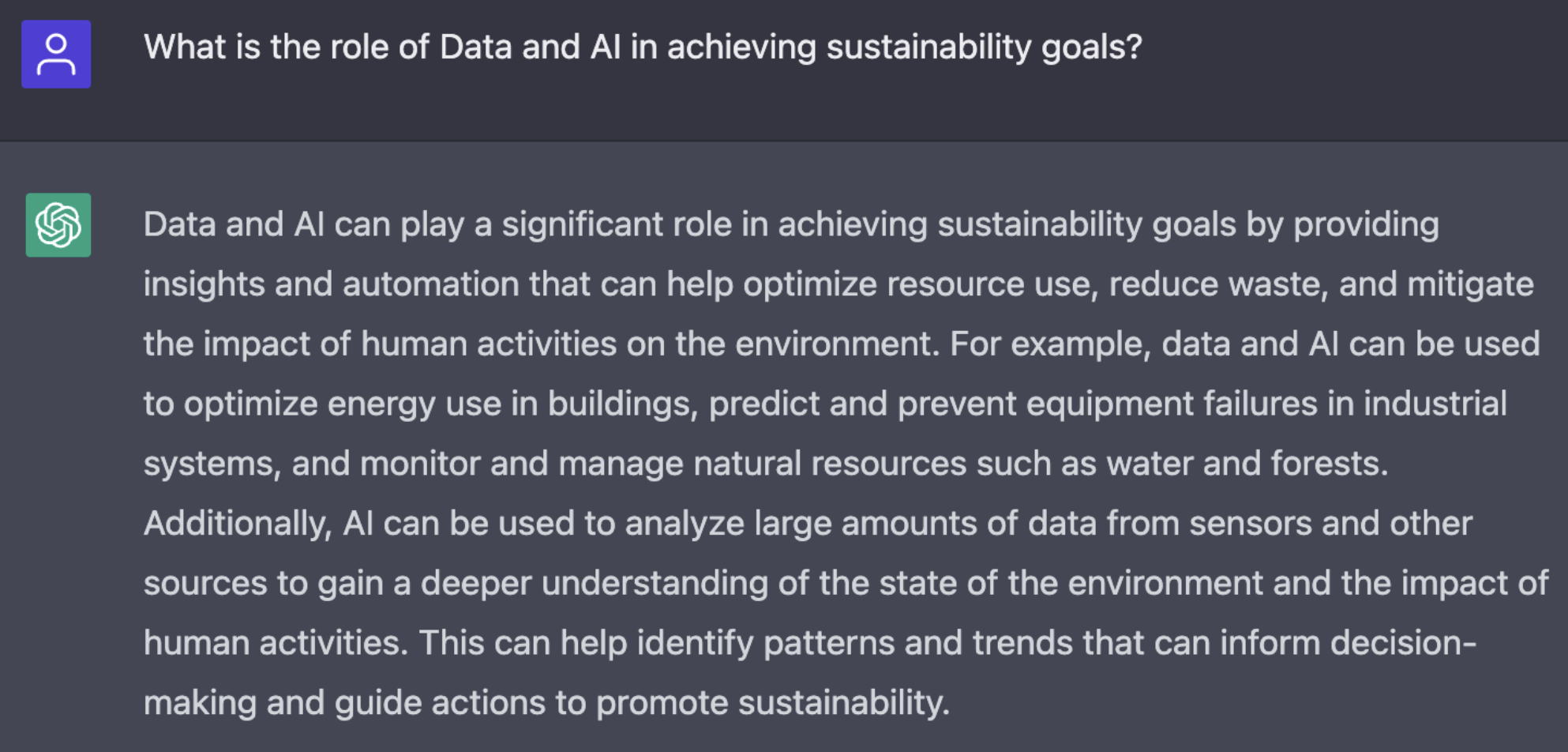Planet Earth is currently operating at 175% of its natural resource capacity and on track to be operating at 200% by the 2030s. This is not sustainable. This is the only planet we call home and it is our responsibility to look after it.
While some companies already engage in sustainability reporting, how do we start managing sustainability challenges? The long-term survival of all organizations requires a safe and liveable planet, and research continues to show that sustainability drives profitability.
Together with my co-chair Peter Jones from Ikano Insight, we asked different industry leaders and sustainability practitioners to join us for an open discussion on how data can be leveraged to achieve sustainability goals.
Before starting the roundtable we asked an actual AI what it thought the role of data and AI should be in solving for sustainability. Here is the response from ChatGPT prompt:

To kick off the conversation, the panel participants were asked to weigh in on the following questions:
- What are you doing today with data and analytics to drive sustainability efforts?
- What do you see as the future for your company? Or, more generally, in using data and analytics to drive sustainability performance?
There was a lively discussion among the panel members. Here are 10 key takeaways from the event:
1. Business growth and sustainability are not at odds with one another. Given the pressures around ESG disclosures, ESG is increasingly becoming non-negotiable to consumers. To drive engagement and customer loyalty, companies should keep sustainability at the forefront of their data strategy.
2. Embedding ESG in company strategy. Companies are increasingly integrating ESG into their corporate strategies. Andreas von Buchwaldt, Grant Mitchell, and Steve Varley of EY (2022) write, “Typically, the necessary data is not captured by legacy processes and systems. CEOs need to identify early the new internal business and impact data they will use to create a true measurement of progress and achievement.” A top-down policy promoting data literacy and sustainability helps make business future-ready.
3. Short-term concerns don’t need to contend with long-term sustainability goals. Profit is the standard bottom line for success, but companies have started to shift data strategies to support the triple bottom line—profit, people, and the planet—to meet the demands of the modern consumer. For many companies, there is a challenge of short-term survival in the current market. With the cost of living crisis, growing international tension, high inflation, and increasing interest rates, companies are even more challenged to prove financial value. Improved data visibility and broader data utilization can help.
4. Compensation and engagement drive human behavior. In order to institutionalize ESG in large organizations, there is a growing pressure to tie senior leadership incentives and bonuses to achieving relevant ESG goals, while also looking at how to integrate these across the whole organization. According to a recent survey by Adobe, workplace sustainability is a must-have for 32% of employees. Companies with established ESG programs experience more employee pride, which is also an important driving factor of sustainability performance and can have an optimal impact on the business overall.
5. The real challenge is sustainability management. Management expert Peter Drucker wrote about how measurement is required for management. The EU Cap and Trade system proposed an approach to incentivize companies to continuously improve their sustainability impact. While reporting identifies the gaps, companies need a data platform that enables it to put a mitigation plan in place, transform business processes, and deliver better results for the environment.
6. Achieving net zero takes time—start with sustainable IT. We are currently in The Second Machine Age, otherwise referred to as The Fourth Industrial Revolution. New technologies in our everyday life are an inevitability. It is critical to design IT systems with sustainability in mind from the ground up. For example, utilizing data infrastructures that can scale compute resources up and down to handle fluctuating demand will inherently be more energy efficient than a data warehouse with regimented sizing.
7. You should use the data you already have. Data collection and disclosure requirements keep shifting. There’s always an opportunity to compile more data, but it’s important to take action with the data that is already available. The key to ensuring that data is actionable is making it governed but accessible, pushing for company-wide data literacy and sharing data where it makes sense with the customer base.
Several Snowflake financial services customers are using Snowflake to simplify their ESG workflows.
8. Businesses need full visibility into the supply chain. What if the supplier several links down the supply chain (“the supplier of my supplier of my supplier …”) is using anti-environmental practices? Which company is responsible for it under the CSRD or Scope-3 regulations? Most companies today do not have visibility into this level of their supply chain. But without this deep visibility, reporting will always be incomplete.
Companies need to build practices that allow us to share data across the entire value chain in a transparent, frictionless, low-latency, and fully governed way.
In addition to internal data and supply chain data, companies need to look at several external sources, such as geospatial data and satellite imagery, to see the bigger picture. This requires different kinds of data sets in different formats. The role of data marketplaces will grow bigger in the future. There are some suppliers in the Snowflake Marketplace, such as Versed.ai, which offer multiple levels of supply chain visibility.
Snowflake Data Collaboration for the Climate Initiative provides customers with a framework to get visibility into their supply chain.
9. Gamification can help engage key stakeholders. Some organizations are using gamification to engage their internal and external stakeholders. This could be an innovative way to get more people to contribute toward ESG targets. You can start building apps, games, and portals based on different data collected to hold sustainability competitions between your employees, customers, and suppliers.
Snowflake customer NatWest bank use Snowflake to collaborate across several areas of the business, including risk teams, retail teams, and ESG teams, to produce in-depth analysis of its customers’ carbon footprints.
10. Data mesh may be the key to understanding and meeting sustainability goals. Data mesh is a decentralized data architecture and operating model in which data is a product and the teams closest to that data own it, rather than a model in which data is pooled together in a single, centralized data lake or warehouse. As the authors of this Thoughtworks data mesh for sustainability article note: “Within a data mesh, sustainability can be defined as a key cross-functional use case for data… That helps the teams closest to that data better understand its sustainability implications, and what they can do to help capture and maintain high-quality, reliable sustainability data.”
A Snowflake customer in the transportation industry Scania uses data mesh and Snowflake’s Data Cloud to drive transport sustainability.
Let’s get to work
We only have one liveable planet and we are all in this together. Modernizing technologies to take full advantage of data and AI can help by providing insights and automation to meet existing sustainability requirements, and prepare us as those requirements evolve.


